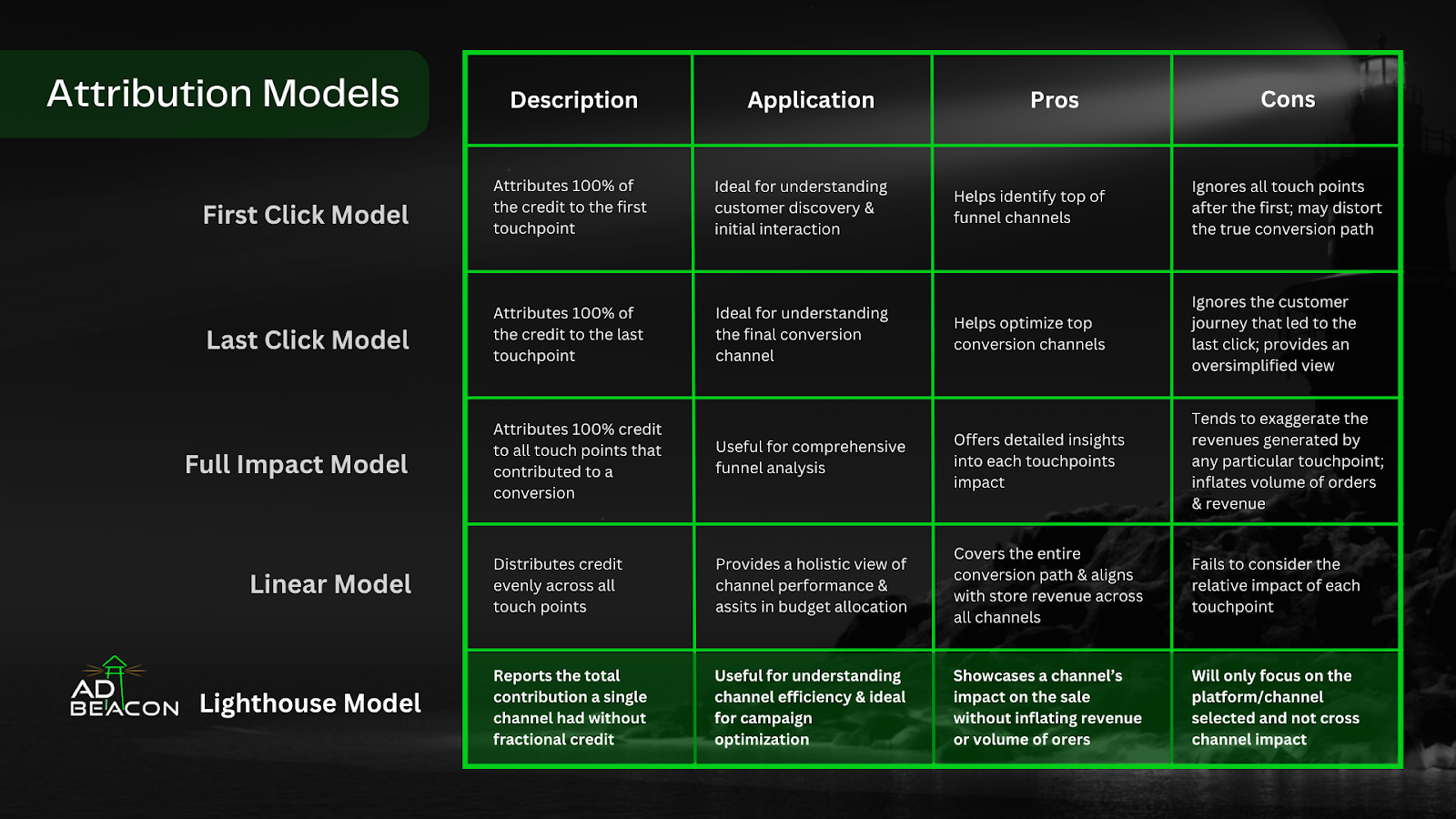In the ever-evolving landscape of digital marketing, the accuracy of attribution models is paramount to effectively gauge the performance of various channels and optimize advertising spend.
AdBeacon leverages first-party data to provide clarity and precision in this critical area. Here’s a closer look at the different attribution models and how they can impact your campaign optimization, complete with examples to illustrate their application.
First Click Attribution Model
The First Click Model attributes 100% of the credit for a conversion to the first interaction a customer has with your brand.
Imagine a customer first clicks on a Facebook ad for your product and then goes through several other touchpoints, such as visiting your website via an email link and finally making a purchase through a Google search ad. The First Click Model attributes the entire conversion credit to the initial Facebook ad click, emphasizing the role of this ad in customer discovery.
Application:
This model is ideal for understanding how customers initially discover your brand.
Pros:
It helps identify the top of the funnel channels, which can be crucial for brand awareness campaigns.
Cons:
By ignoring all subsequent interactions, this model may distort the true conversion path and undervalue the influence of later interactions.
Last Click Attribution Model
Conversely, the Last Click Model attributes 100% of the conversion credit to the final touchpoint.
Using the same journey as above, where the customer first interacted with a Facebook ad, visited the website via an email link, and finally made a purchase through a Google search ad.
The Last Click Model attributes the entire conversion credit to the Google search ad, highlighting the effectiveness of the final touchpoint that led to the sale.
Application:
It is best used for understanding the effectiveness of the final conversion channels.
Pro:
This model helps optimize the channels that drive final conversions.
Cons:
It overlooks the entire customer journey, offering an oversimplified view that ignores the initial and middle interactions that contributed to the conversion.
Full Impact Attribution Model
The Full Impact Model attributes 100% credit to all touchpoints that contributed to a conversion, providing a comprehensive analysis of the customer journey.
In our journey example, the Full Impact Model would attribute equal credit to the Facebook ad, the email link visit, and the Google search ad, giving a balanced view of how each touchpoint contributed to the final conversion.
Application:
This model is useful for a detailed funnel analysis.
Pro:
It offers insights into the impact of each touchpoint, facilitating a thorough understanding of the customer journey.
Cons:
It tends to exaggerate the revenue generated by any particular touchpoint, potentially inflating order volumes and revenue figures.
Linear Attribution Model
The Linear Model distributes credit evenly across all touchpoints in the customer journey. With the Linear Model, the same customer journey would see credit divided equally among the Facebook ad, the email visit, and the Google search ad.
Each touchpoint gets an equal share of the credit for the conversion, providing a balanced attribution.
Application:
It provides a holistic view of channel performance and assists in balanced budget allocation.
Pro:
This model covers the entire conversion path and aligns with store revenue across all channels.
Cons:
It fails to consider the relative impact of each touchpoint, which can dilute the understanding of the most effective channels.
Lighthouse “Optimization” Model (AdBeacon’s Exclusive)
AdBeacon’s proprietary Lighthouse Model reports the total contribution of a single channel without fractional credit.
In the same customer journey, if you chose to analyze the contribution of the Google search ad using the Lighthouse Model, you would see the total impact this channel had on sales without dividing credit among other touchpoints. This approach highlights the specific contribution of the Google search ad to the overall conversion.
Application:
This model is ideal for understanding channel efficiency and is particularly useful for campaign optimization.
Pro:
It showcases a channel’s impact on sales without inflating revenue or order volumes, offering clear insights into channel performance.
Cons:
It focuses solely on the selected platform/channel and does not consider the cross-channel impact, which could be limiting in a multi-channel strategy.
Why Choose AdBeacon?
AdBeacon combines these attribution models with the power of first-party data to deliver highly accurate and actionable insights. By focusing on objective click data and real-time reporting, AdBeacon ensures media buyers and brands can optimize their spend efficiently to maximize profits.
Attribute Your Success - Wisely
Selecting the right attribution model is crucial for understanding and optimizing your marketing efforts. Whether you need a model that emphasizes the first interaction or one that provides a balanced view of all touchpoints, AdBeacon’s advanced attribution solutions and first-party data capabilities empower you to make informed decisions that drive profitability and growth.
AdBeacon is designed to meet the needs of modern media buyers, providing the tools and insights necessary to navigate the complexities of digital advertising. With AdBeacon, you can confidently optimize your campaigns and achieve superior performance outcomes.
If you haven’t seen AdBeacon in action – book your demo today to experience our game-changing technology!
